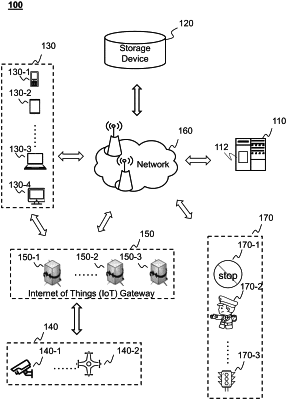| CPC G08G 1/0145 (2013.01) [G08G 1/0133 (2013.01); G08G 1/052 (2013.01)] | 19 Claims |

|
1. A method for traffic scheduling at an intersection in a smart city, executed by a traffic scheduling strategy control management platform, comprising:
determining, based on a road monitoring video of the intersection in a preset area before a current time, a first average speed of each vehicle among a plurality of vehicles on one or more roads connected with the intersection before the current time;
determining a number of first vehicles, wherein the first average speed of each first vehicle is less than a first preset threshold;
obtaining the road monitoring video of the intersection at the current time when the number of the first vehicles is greater than a second preset threshold;
obtaining, based on the road monitoring video at the current time, a second average speed of each vehicle among the plurality of vehicles at the current time;
determining a number of second vehicles, wherein the second average speed of each second vehicle is less than the first preset threshold;
determining whether traffic congestion is likely to occur at the intersection during a next time period based on a comparison result obtained by comparing the number of the first vehicles with the number of second vehicles;
in response to determining that the traffic congestion is likely to occur at the intersection during the next time period, determining whether a traffic scheduling strategy is needed to be switched based on traffic data information of the intersection during the next time period; and
in response to determining that the traffic scheduling strategy is needed to be switched, switching a first traffic scheduling strategy to a second traffic scheduling strategy.
|